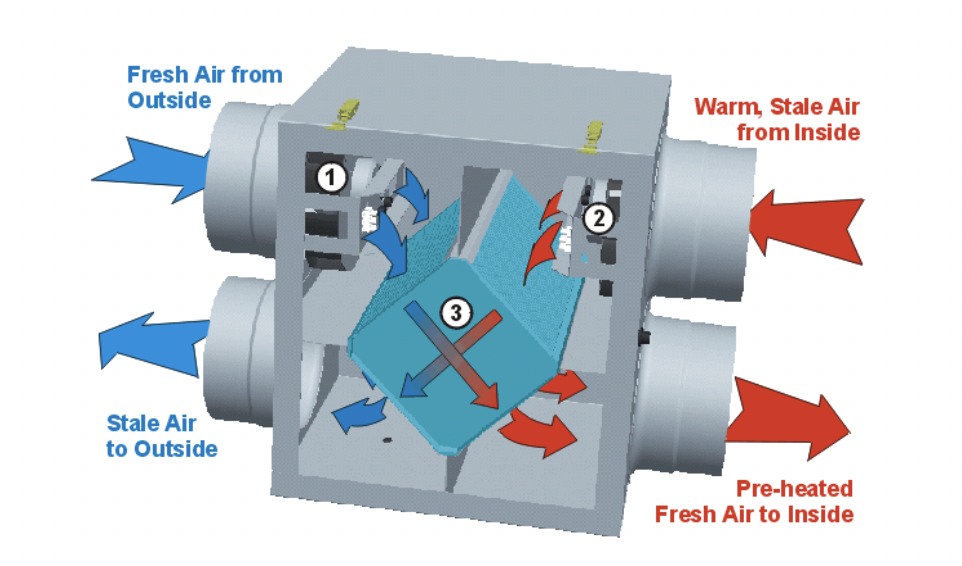Energy Recovery Systems
New ResidentialWhat are Energy Recovery Systems?
Energy recovery systems transfer heat from outgoing air to incoming air in the winter and from incoming air to outgoing air in the summer, lowering heating and cooling costs and overall energy use. There are different types of systems, all featuring a heat exchanger, controls, and one or more fans to move air through a machine.
Energy recovery technologies include heat-recovery ventilators (HRV) and energy-recovery ventilators (ERV). Energy-efficient, tightly sealed, homes require proper ventilation. Energy recovery ventilators (ERV) minimize energy loss while ventilating the home. Most systems include central, whole-house ventilators, but some smaller models can be mounted on walls or windows.

Figure 1 – Energy Recovery System Diagram (Source: DPoint Technologies)
How to Implement Energy Recovery Systems
Select ERV systems certified by the Home Ventilating Institute that comply with local building codes for HVAC systems. Most energy recovery systems can share existing ductwork, which reduces maintenance and installation costs. Each room requires a supply and return duct. Proper installation, sizing, and placement of ducts as well as regular maintenance can impact performance.[1] In cold climates, energy recovery ventilators must have a device to prevent freezing and frost formation.[2] Experienced and qualified HVAC contractors should install, properly test, and balance the system. Improperly balanced systems can lead to negatively pressurized homes that backdraft from combustion appliances, drawing carbon monoxide and gases, such as radon, into the home.[3]
Example
This multifamily project demonstrates significant energy improvements as well as annual energy savings by installing energy-efficient measures including an Energy Recovery Ventilation (ERV) system.
Benefits
Energy recovery systems can recover about 70-80% of the energy in exiting air and transfer it to incoming air reducing energy consumption and costs.[4] By controlling humidity and cycling in fresh air to replace stale or contaminated indoor air, ERV’s improve indoor air quality and comfort in the home.
Costs
While costs vary according to quality, capacity, controls, efficiency, and type, medium-sized (70-120cfm) energy recovery ventilators generally cost between $600 and $1100, not including installation.[5] These systems are most cost-effective in climates with cold winters and hot summers, such as New Jersey, or where fuel costs are high.[6] Generally, energy recovery systems cost more to install than conventional systems and require more maintenance over their lifetime, but when correctly installed, can help reduce energy bills, and provide a healthier indoor environment.
Resiliency
Energy recovery systems offer an indirect resiliency benefit to buildings by reducing heating and cooling loads, thereby reducing stress on the grid, and the likelihood of brownouts.
[1] University of Minnesota (UMN). Minnesota Sustainable Housing Initiative. Heat and Energy Recovery Ventilators http://www.mnshi.umn.edu/kb/scale/hrverv.html (accessed April 16, 2018).
[2] US DOE Energy Savers. Whole House Ventilation. https://www.energy.gov/energysaver/weatherize/ventilation/whole-house-ventilation (accessed April 16, 2018).
[3] D. Kosar. 2016. Laboratory Evaluation of Energy Recovery Ventilators Building America Partnership for Improved Residential Construction. https://www.nrel.gov/docs/fy17osti/66560.pdf (accessed April 16, 2018).
[4] US DOE Energy Savers. Whole House Ventilation. https://www.energy.gov/energysaver/weatherize/ventilation/whole-house-ventilation (accessed April 16, 2018).
[5] University of Minnesota (UMN). Minnesota Sustainable Housing Initiative. Heat and Energy Recovery Ventilators http://www.mnshi.umn.edu/kb/scale/hrverv.html (accessed April 16, 2018).
[6] Sustainable Sources. “Energy Recovery Ventilation Systems.” http://sustainablesources.com (accessed April 16, 2018).
Related Strategies
Resources
- Home Ventilating Institute
- National Resources Canada (NRCan): Heat/Energy Recovery Systems
- Passive House Institute US (PHIUS)+ 2015 Project Certification
- University of Minnesota Sustainable Housing Initiative. Heat and Energy Recovery Ventilators
- US DOE: Energy Savers Whole House Ventilation
- US DOE: Zero Energy Ready Home
- US EPA Indoor AirPLUS
